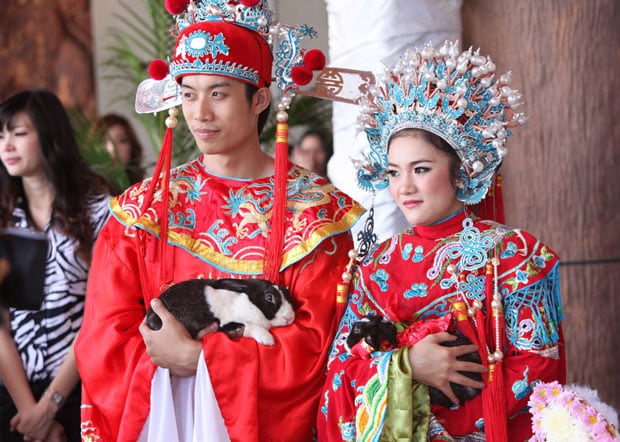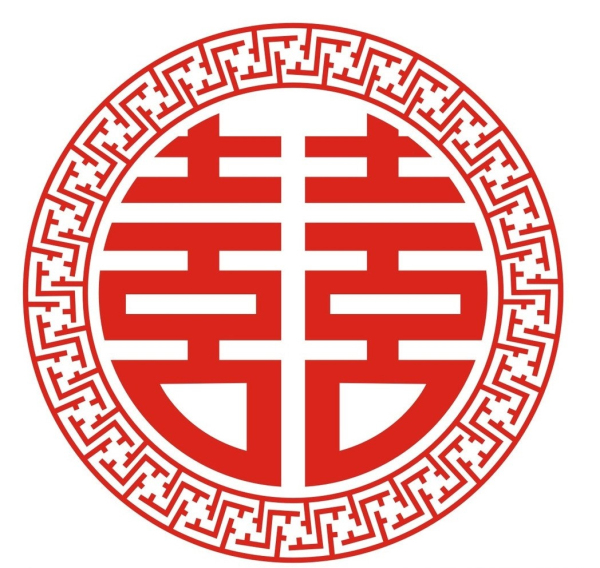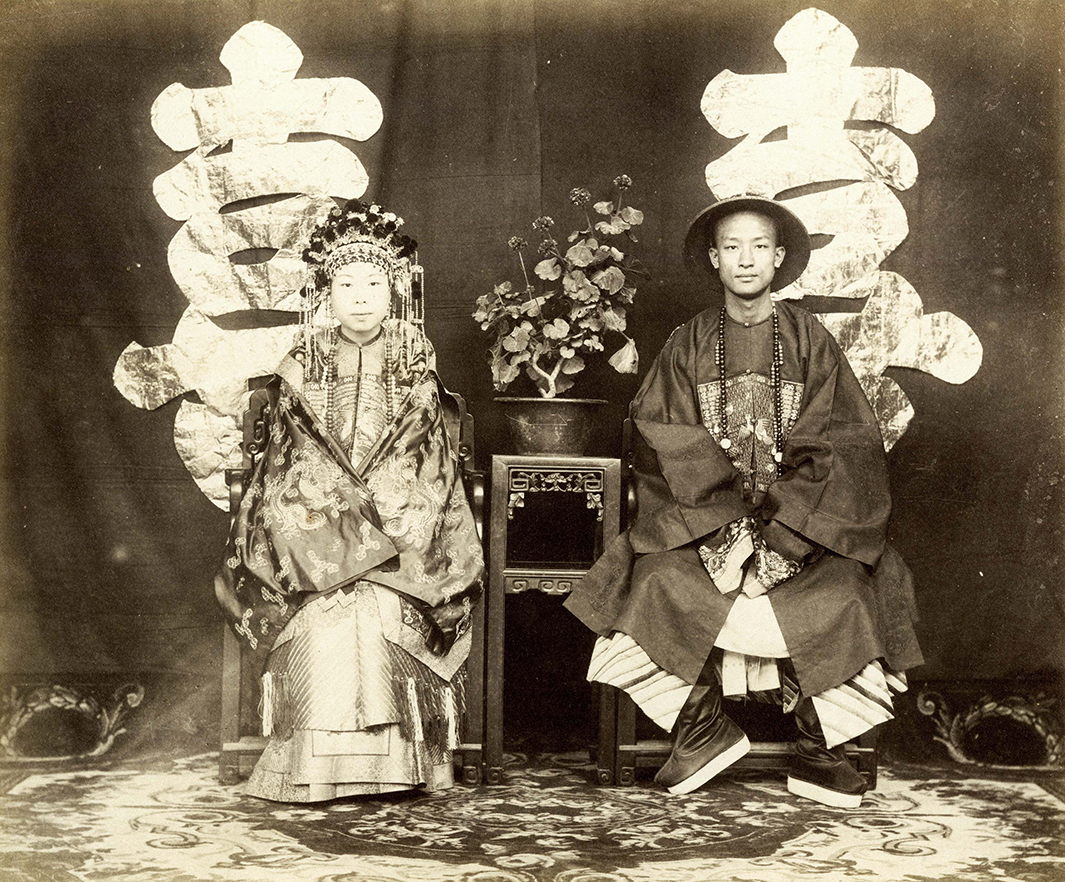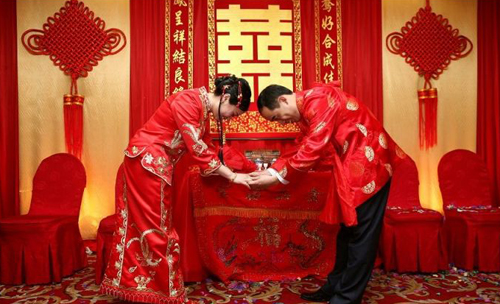"I do" in Ancient China
By Nadia N.
 I do, 一句浪漫又经典的对白--在生活中,在影视剧里,在世界各个角落、每时每刻,大概都可能有一个人说出这样一句感动对方的承诺和誓言。从过去的"父母之命,媒妁之言",到如今的自由恋爱,两情相悦,并最终彼此承诺伴侣关系,这个演变的进程持续了几百年。
I do, 一句浪漫又经典的对白--在生活中,在影视剧里,在世界各个角落、每时每刻,大概都可能有一个人说出这样一句感动对方的承诺和誓言。从过去的"父母之命,媒妁之言",到如今的自由恋爱,两情相悦,并最终彼此承诺伴侣关系,这个演变的进程持续了几百年。
谈及中国的婚姻,可以从原始时代说起。中国这块神奇的土地是最早出现原始人的地方之一,那时的人没有固定配偶,婚姻制度并不存在。随着社会不断发展,在新石器时代,父母与子女之间的界限被划分出来,但兄弟姐妹之间的婚姻依然存在。直至新石器时代晚期,同家族的近亲之间的婚姻开始被禁止,一夫多妻制也开始出现并在随后的封建制度社会体系中逐步确立。
儒家思想的正统地位确立后,大大影响了中国千百年来的思想文化。婚姻的重要性也日益凸显,君权父权夫权不可逾越。妇女实际成为男人的附庸与财产。此时期的另一个特点是,出身对婚配起到了决定性的影响。不同阶层的人几乎不可能彼此联姻嫁娶。
封建社会时期,男女之间的互动也受到严格约束,新郎新娘在婚前都不可以见到对方,一切听从父母的安排。古代结婚的仪程则更为复杂,要三书六礼(也叫三媒六聘)方能迎娶回家。总而言之,中国的婚姻制度与习俗在历史的发展中已经有了巨大的变化,这也再次证明了中国社会文化的丰富多样。
 Birthday, marriage and funeral - these three steps were certain "key points of life" for many cen-turies in a variety of cultures across the world. As for celebration of one's birth and holding a cer-emony to honor someone who passed away, the significance and desire of people to mark these two events is quite understandable. However, in many countries in different times marriage - find-ing a partner for life and making the relationship "official" - has been also a kind of unavoidable milestone for one's life path. In China, where strong traditional cultures merge with the modern life style, marriage, its perception, customs and social importance has passed through the most amazing metamorphose.
Birthday, marriage and funeral - these three steps were certain "key points of life" for many cen-turies in a variety of cultures across the world. As for celebration of one's birth and holding a cer-emony to honor someone who passed away, the significance and desire of people to mark these two events is quite understandable. However, in many countries in different times marriage - find-ing a partner for life and making the relationship "official" - has been also a kind of unavoidable milestone for one's life path. In China, where strong traditional cultures merge with the modern life style, marriage, its perception, customs and social importance has passed through the most amazing metamorphose.
 In primitive times, people in China lived in large groups and didn't have a fixed spouse. Therefore, marriage as such didn't exist during that time. With the evolving of society, with the arriving of the first "marriage taboo" during the middle Neolithic age, parent-offspring relationship became restricted. However people of the same generations still could create a meaningful relationship. In Chinese folklore there are plenty of myths and legends about couples who were in fact brothers and sisters.
In primitive times, people in China lived in large groups and didn't have a fixed spouse. Therefore, marriage as such didn't exist during that time. With the evolving of society, with the arriving of the first "marriage taboo" during the middle Neolithic age, parent-offspring relationship became restricted. However people of the same generations still could create a meaningful relationship. In Chinese folklore there are plenty of myths and legends about couples who were in fact brothers and sisters.
Later, in the late Neolithic age, another "marriage taboo" prohibited society to marry any blood relatives and introduced the concept of exogamous marriage. This way, traditionally men could have several spouses. Later during the same period, society went on to the stage of monogamic relationship, but it is quite different from how we picture "monogamy" to be now. Even if, as es-tablished by the law, man and woman were bound to only one partner, each could have extramar-ital affairs that were tolerated by the society as well. As time passed and people started to estab-lish ownership of property, lands and all kinds of things, monogamy passed into the new stage. In fact, as patriarchy blossomed during this period of social development, all the property (including that of the wife) belonged solely to the husband.
With Confucianism becoming the major philosophy of Chinese people, its influence, of course, changed people's perception of marriage. In that period marriage grew to be the very basis of the society itself and its importance grew even greater making it the fundamental aspect of ethics.
 Free love and all kinds of interaction between men and women of marriageable age were totally banned in China for the period of numerous dynasties and therefore any expression of attraction or affection between them was punishable by law as an offensive act against common decency. Marriages had to be very well pre-arranged by two families based mostly on economical and sta-tus advantages the union could bring. Matchmakers played quite a significant role in arranging this "partnership". They followed the strict pattern and checked the compatibility of families. Future husband and wife couldn't see each other before the wedding ceremony and relied on their families in choosing the perfect partner.
Free love and all kinds of interaction between men and women of marriageable age were totally banned in China for the period of numerous dynasties and therefore any expression of attraction or affection between them was punishable by law as an offensive act against common decency. Marriages had to be very well pre-arranged by two families based mostly on economical and sta-tus advantages the union could bring. Matchmakers played quite a significant role in arranging this "partnership". They followed the strict pattern and checked the compatibility of families. Future husband and wife couldn't see each other before the wedding ceremony and relied on their families in choosing the perfect partner.
In smilingly quite strict society, polygamy was still more than alive through all these years of growing importance of feudalistic monogamy. The narrow getaway appeared when polygamy wasn't culturally prohibited and wasn't openly tolerated. Therefore, in majority of prearranged marriages, especially for higher and middle classes, having one "formal" and multiple "informal" partners was very common (men and multiple women).
If nowadays we complain daily about the paperwork we are required to do to go through official procedures, to marry in olden China was even more so. Tradition dictates that every marriage should have Three Marriage Letters and Six Etiquettes. Three letters were the documents that needed to be submitted in order to "close the deal": Betrothal Letter (a contract), Gift letter (list of offered gifts) and Wedding Letter (welcoming document for the bride into the groom's house). Six etiquettes were the customs that needed to be strictly followed in order to organize the mar-riage: proposing marriage, matching birthdates, submitting wedding gifts, presenting the gifts, selecting the date and holding the ceremony.
As wedding and marriage were doubtlessly of great importance for ancient Chinese people, not only traditions and customs but also large number of superstitions covered this meaningful day.
All in all, marriage in China has evolved greatly for the last decades and proves one more time how complicated, vast and many-sided the Chinese culture is.
---END---